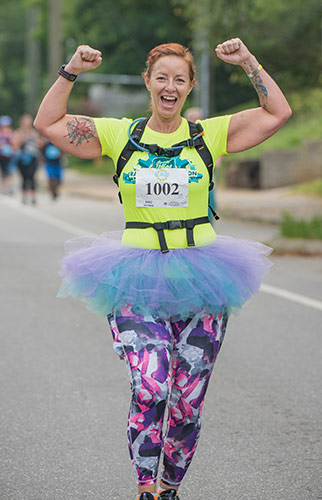Running a race on mixed surface
 by Tom Mangan
by Tom Mangan
“Running a race on mixed surface and terrain can be better on your body during the race and for post-race recovery.”
How does that commercial go…I’m no doctor, but I did stay at a Holiday Inn Express last night. Disclaimers away, here it goes.
We runners love our routines, and where we choose to run is no exception. Some favor pounding the pavement or tearing up the treadmill for 100 miles (don’t knock it ‘til you’ve tried it!), while others enjoy speeding on the track, or tackling the trails. There is a good likelihood that many of us don’t stray too far from our favorites. Ah…comfort zones. They’re so…comfy. As a result, we are limiting some of the physical benefits we might receive during our run.
One of the many unique characteristics of the Asheville Marathon and Half at Biltmore Estate is that both courses cover a variety of running surfaces. Quite a few runners, when first learning of the varied surfaces of their course, start questioning the shoes they plan to wear on race day. (Oh, how we runners love to think about shoes. A lot. And food. Lots of food. But I digress…)
Once we manage to pry ourselves away from thoughts of shoes and food, we start poring over the course description on the race website and our eyes land on “breathtaking.” Thankful that it’s describing the sights rather than how we’ll feel running up the hill at mile four, we move on to read the course has some pavement, some large gravel, some crushed gravel, some packed dirt, along with some concrete and wood on the bridges. Ultra runners are itching to make a spreadsheet at this point. Let the overthinking begin!
Running on a variety of surfaces engages different leg muscles and works leg muscles differently. For example, running on trails makes you engage a lot of little stabilizer muscles that you may not use running all of your miles on the roads. Running on asphalt allows you focus on form and consistency while firing your fast-twitch muscles, whereas running on gravel and carriage roads can put emphasis on your quads and ankles because each step is slightly different than the next. Just like snowflakes, no two are alike. These running surfaces tend to be easier on the joints because they absorb and disperse impact. Additionally, the tiny adjustments made on each stride help build strength in the small muscles of your calves and thighs, which have to work harder to stabilize your legs on unstable or uneven surfaces.
But fear not. In fact, there is good news. Running a race on mixed surface and terrain can aid in post-race recovery. Many of us are used to marathons that take us through the heart of downtown on pavement – which is ten times as hard as asphalt (who knew?!) – and one of the worst surfaces on which to run. The damage that can cause over 48,000 steps is remarkable. The simple explanation is that post-race recovery is faster because you didn’t do as much damage in the first place, and any effects are spread over more of your body.
On a multi-surface course such as Asheville, there is something for everyone. The course layout is such that you never run on a single surface for too long before there is a transition, yet the entire course is runnable. One of the reasons so many run the Backyard to Vineyard Challenge or the Backyard to Backyard Challenge is because their bodies don’t take a tough beating at the Saturday race that they can run well on Sunday, too. As one who has run the Backyard to Vineyard Challenge each year it’s been held, I’ve never had to do “the marathon walk” the day after the marathon and my body hasn’t been as fatigued as it would be at other races.
Knowing this, the only thing left to do now (other than register) is to decide which shoes to wear on race day. Without recommending a particular brand or model, I’d simply suggest a comfortable road shoe. There is no need for a trail shoe at Asheville and I’d recommend against a racing flat for all but those who are truly racing because many runners prefer a little more cushion when running on gravel. With 2 ½ months until race day, it should give you something to think about. That…and second breakfast.
If you’re like me (there’s a scary thought), you’re thinking about buying some shoes to wear at Asheville. Do yourself a favor and keep that new year’s resolution to save money. Use code “NEWYOU2020” (expires January 31st, 2020 at midnight) to save $10 when you register. Look for me at the expo and let me know what shoes you decided to wear. Good luck with your training.
Tom Mangan is an Asheville Marathon & Half Ambassador.



